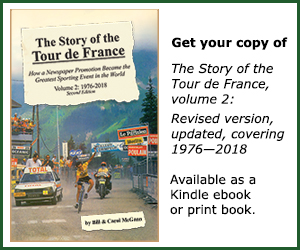

1931 Giro d'Italia
19th edition: May 10 - May 31
Results, stages with running GC
1930 Giro | 1932 Giro | Giro d'Italia Database | 1931 Giro Quick Facts | 1931 Giro d'Italia Final GC | Stage results with running GC | Teams

The Golden Sayings of Epictetus is available as an audiobook here. For the Kindle eBook version, just click on the Amazon link on the right.
3012 km raced at an average speed of 29.33 km/hr
109 starters and 65 classified finishers
12 stages with an average stage length of 251 km.
The Giro awarded the maglia rosa (Pink Jersey) for the first time, the jersey being the same color as the paper used by La Gazzetta dello Sport, the Giro's owner.
Alfredo Binda abandoned while leading after crashing in stage six.
Francesco Camusso performed a brilliant escape in stage 11, catching everyone by surprise and thereby winning the 1931 Giro d'Italia.
1931 Giro d'Italia Final General Classification:
 Francesco Camusso (Gloria): 102hr 40min 46sec
Francesco Camusso (Gloria): 102hr 40min 46sec- Luigi Giacobbe (Maino) @ 2min 47sec
- Luigi Marchisio (Legnano) @ 6min 15sec
- Aristide Cavallini (independent-Dei) @ 10min 15sec
- Ettore Balmamion (independent-Frejus) @ 12min 15sec
- Augusto Zanzi (Ganna) @ 12min 16sec
- Antonio Pesenti (independent) @ 13min 50sec
- Ambrogio Enrico Morelli (Bianchi) @ 16min 59sec
- Felice Gremo (Legnano) @ 27min 5sec
- Eugenio Gestri (Legnano) @ 32min 25sec
- Michele Orecchia @ 33min 55sec
- Antonio Giuseppe Negrini @ 40min 31sec
- Alfredo Bovet @ 42min 25sec
- Severino Canavesi (Gloria) @ 46min 13sec
- Renato Scorticati (independent) @ 51min 10sec
- Casimiro Bianchin @ 1hr 2min 35sec
- Aldo Canazza (Legnano) @ 1hr 3min 35sec
- Mario Cipriani @ 1hr 24min 2sec
- Amerigo Cacioni @ 1hr 34min 12sec
- Oreste Cignoli @ 1hr 39min 46sec
- Amilcare Galloni @ 1hr 41min 42sec
- Aleardo Simoni @ 1hr 44min 8sec
- Albino Binda (Legnano) @ 1hr 47min 8sec
- Alfonso Crippa @ 1hr 48min 21sec
- Mario Pomposi @ 1hr 49min 17sec
- Carlo Rovida @ 1hr 51min 32sec
- Raffaele Perna @ 2hr 0min 4sec
- Allegro Grandi @ 2hr 3min 10sec
- Antonin Magne @ 2hr 7min 33sec
- Piero Fossati @ 2hr 9min 23sec
- Ettore Meini (independent) @ 2hr 19min 14sec
- Angelo Rinaldi @ 2hr 24min 44sec
- Raffaele Di Paco @ 2hr 34min 51sec
- Luigi Barral @ 2hr 37min 6sec
- Domenico Puleo @ 2hr 37min 35sec
- Giovanni Vitali @ 2hr 40min 15sec
- Giovanni La Rocca @ 2hr 41min 44sec
- Mario Lavazza @ 2hr 42min 48sec
- Mario Semprini @ 2hr 48min 27sec
- Armando Gori @ 2hr 48min 48sec
- Pietro Mori @ 2hr 49min 35sec
- Emilio Codazza @ 2hr 52min 17sec
- Luigi D'Alessandria @ 3hr 49min 23sec
- Angelo Giannini @ 4hr 14min 38sec
- Umberto Berni @ 4hr 51min 43sec
- Eraldo Fornari @ 5hr 11min 52sec
- Giovanni Pizzarelli @ 5hr 17min 33sec
- Gaetano Riva @ 5hr 53min 52sec
- Francesco De Fano @ 5hr 57min 55sec
- Adolfo Martelli @ 6hr 26min 10sec
- Nicola Ranieri @ 6hr 39min 20sec
- Giulio Fatticcioni @ 6hr 46min 58sec
- Francesco Riccò @ 7hr 32min 12sec
- Antonio Vani @ 7hr 51min 27sec
- Giuseppe Martorana @ 8hr 12min 32sec
- F. D'Adam @ 8hr 50min 47sec
- Ermete Fuccella @ 10hr 3min 19sec
- Arnaldo Bergami @ 10hr 46min 59sec
- Riccardo Gagliardi @ 10hr 47min 59sec
- Attilio Laus @ 14hr 5min 19sec
- Tullo Vincenzi @ 14hr 10min 19sec
- Giuseppe Paltrinieri @ 14hr 11min 26sec
- Bruno Fontana @ 14hr 23min 39sec
- Luigi Ugaglia @ 14hr 47min 19sec
- Alberto Mongiano @ 17hr 45min 34sec
1931 Giro stage results with running GC:
Stage 1: May 10, Milano - Mantova, 206 km
- Learco Guerra: 6hr 7min 19sec
- Alfredo Binda s.t.
- Michele Mara s.t.
- Luigi Marchisio s.t.
- Fabio Battesini s.t.
- Raffaele Di Paco s.t.
- Domenico Piemontesi @ 7sec
- Jean Aerts s.t.
- Aldo Canazza s.t.
- Ettore Balmamion s.t.
Stage 2: Monday, May 11, Mantova - Ravenna, 216 km
- Learco Guerra: 7hr 3min 10sec
- Fabio Battesini s.t.
- Michele Mara s.t.
- Alfredo Binda s.t.
- Domenico Piemontesi s.t.
- Raffaele Di Paco s.t.
- Jean Aerts s.t.
- Alfredo Bovet s.t.
- Ambrogio Morelli s.t.
- Alfonso Crippa s.t.
GC after Stage 2:
- Learco Guerra: 13hr 10min 29sec
- Alfredo Binda s.t.
- Fabio Battesini s.t.
- Michele Mara s.t.
- Raffaele Di Paco s.t.
- Luigi Marchisio s.t.
- Domenico Piemontesi @ 7sec
- Jean Aerts s.t.
- Ettore Balmamion s.t.
- Alfredo Carniselli
Stage 3: Tuesday, May 12, Ravenna - Macerata, 288 km
![]() Ascents: Urbino (400m), Passo di Scheggia (632m), Colle di Fossato (740m)
Ascents: Urbino (400m), Passo di Scheggia (632m), Colle di Fossato (740m)
- Alfredo Binda: 10hr 16min 26sec
- Luigi Giacobbe s.t.
- Michele Mara s.t.
- Louis Delannoy s.t.
- Luigi Marchisio s.t.
- Louis Peglion s.t.
- Aleardo Simoni s.t.
- Eugenio Gestri s.t.
- Luigi Barral s.t.
- Giovanni Firpo s.t.
GC after Stage 3:
- Alfredo Binda: 23hr 35min 55sec
- Michele Mara @ 1min 0sec
- Luigi Marchisio s.t.
- Eugenio Gestri @ 1min 7sec
- Luigi Giacobbe s.t.
- Louis Peglion s.t.
- Aleardo Simoni s.t.
- Luigi Barral @ 1min 31sec
- Giovanni Firpo s.t.
- Augusto Zanzi @ 1min 43sec
Stage 4: Friday, May 15, Macerata - Pescara, 234 km
![]() Ascent: Croce di Casale (731m)
Ascent: Croce di Casale (731m)
- Alfredo Binda: 8hr 11mi 3sec
- Learco Guerra s.t.
- Michele Mara s.t.
- Luigi Marchisio s.t.
- Domenico Piemontesi s.t.
- Aldo Canazza s.t.
- Giovanni Firpo s.t.
- Jean Aerts s.t.
- Luigi Barral s.t.
- Perosa s.t.
GC after Stage 4:
- Alfredo Binda: 31hr 47min 8sec
- Michele Mara @ 1min
- Luigi Marchisio s.t.
- Eugenio Gestri @ 1min 7sec
- Luigi Giacobbe s.t.
- Louis Peglion s.t.
- Luigi Barral @ 1min 21sec
- Giovanni Firpo s.t.
- Augusto Zanzi s.t.
- Alfredo Bovet @ 1min 33sec
Stage 5: Sunday, May 17, Pescara - Napoli, 282.5 km
![]() Ascents: Ponte Cottaro (1,012m), Roccaraso (1,236m)
Ascents: Ponte Cottaro (1,012m), Roccaraso (1,236m)
- Michele Mara: 10hr 48min 18sec
- Learco Guerra s.t.
- Alfredo Binda s.t.
- Domenico Piemontesi s.t.
- Eugenio Gestri s.t.
- Luigi Marchisio s.t.
- Ettore Balmamion s.t.
- Raffaele Di Paco s.t.
- Felice Gremo s.t.
- Carlo Rovida s.t.
GC after Stage 5:
- Alfredo Binda: 42hr 35min 26sec
- Michele Mara @ 1min
- Luigi Marchisio s.t.
- Eugenio Gestri @ 1min 7sec
- Luigi Giacobbe @ 1min 15sec
- Giovanni Firpo @ 1min 21sec
- Luigi Barral @ 1min 29sec
- Augusto Zanzi @ 1min 41sec
- Louis Peglion @ 1min 56sec
- Alfredo Bovet @ 2min 1sec
Stage 6: Tuesday, May 19, Napoli - Roma, 265 km
![]() Ascent: Palestrina
Ascent: Palestrina
- Ettore Maini: 7hr 50min 37sec
- Antonio Pesenti s.t.
- Renato Scorticati s.t.
- Ettore Balmamion s.t.
- Amerigo Cacioni s.t.
- Aristide Cavallini s.t.
- Casimiro Bianchin s.t.
- Oreste Cignoli @ 10sec
- Learco Guerra @ 25sec
- Michele Mara s.t.
GC after Stage 6:
- Michele Mara: 50hr 27min 28sec
- Luigi Marchisio @ 12sec
- Alfredo Binda @ 15sec
- Eugenio Gestri @ 19min
- Luigi Giacobbe @ 33sec
- Aristide Cavallini @ 43sec
- Louis Peglion @ 1min 6sec
- Luigi Barral @ 1min 47sec
- Augusto Zanzi @ 1min 52sec
- Francesco Camusso @ 2min 8sec
Stage 7: Thursday, May 21, Roma - Perugia, 247 km
![]() Ascent: Passo della Somma
Ascent: Passo della Somma
- Learco Guerra: 7hr 55min 26sec
- Francesco Camusso @ 36sec
- Severino Canavesi @ 1min 1sec
- Luigi Giacobbe s.t.
- Luigi Marchisio s.t.
- Augusto Zanzi s.t.
- Felice Gremo @ 1min 10sec
- Ettore Balmamion @ 1min 18sec
- Michele Mara @ 1min 45sec
- Ambrogio Morelli s.t.
GC after Stage 7:
- Luigi Marchisio: 58min 24min 7sec
- Luigi Giacobbe @ 21sec
- Michele Mara @ 32sec
- Eugenio Gestri @ 51sec
- Francesco Camusso @ 1min 31sec
- Augusto Zanzi @ 1min 40sec
- Learco Guerra @ 2min 21sec
- Ettore Balmamion @ 2min 29sec
- Aristide Cavallini @ 2min 57sec
- Ambrogio Morelli @ 3min 21sec
Stage 8: Saturday, May 23, Perugia - Montecatini, 246 km
- Learco Guerra: 7hr 48min 13sec
- Michele Mara @ 35sec
- Raffaele Di Paco s.t.
- Luigi Marchisio s.t.
- Carlo Rovida s.t.
- Domenico Piemontesi s.t.
- Ambrogio Morelli s.t.
- Eugenio Gestri s.t.
- Antonin Magne @ 42sec
- Antonio Pesenti s.t.
GC after Stage 8:
- Learco Guerra: 66hr 12min 41sec
- Luigi Marchisio @ 14sec
- Luigi Giacobbe @ 42sec
- Michele Mara @ 46sec
- Eugenio Gestri @ 1min 1sec
- Francesco Camusso @ 1min 52sec
- Augusto Zanzi @ 2min 16sec
- Ettore Balmamion @ 3min 0sec
- Aristide Cavallini @ 3min 33sec
- Ambrogio Morelli @ 3min 35sec
Stage 9: Monday, May 25, Montecatini - Genova, 248 km
![]() Ascents: La Foce (613m), Bracco (613m)
Ascents: La Foce (613m), Bracco (613m)
- Michele Mara: 8hr 58min 50sec
- Luigi Giacobbe s.t.
- Domenico Piemontesi s.t.
- Carlo Rovida s.t.
- Ettore Balmamion s.t.
- Luigi Marchisio s.t.
- Francesco Camusso s.t.
- Renato Scorticati @ 12sec
- Antonio Pesenti s.t.
- Umberto Berni s.t.
GC after Stage 9:
- Luigi Marchisio: 75hr 11min 45sec
- Luigi Giacobbe @ 28sec
- Michele Mara @ 32sec
- Eugenio Gestri @ 1min 3sec
- Francesco Camusso @ 1min 38sec
- Augusto Zanzi @ 2min 14sec
- Ettore Balmamion @ 2min 46sec
- Aristide Cavallini @ 3min 31sec
- Antonio Negrini @ 4min 38sec
- Ambrogio Morelli @ 5min 31sec
Stage 10: Wednesday, May 27, Genova - Cuneo, 263 km
![]() Ascents: La Bocchetta (772m), Colle del Giovo (472m), Colle di Cadibona (734m)
Ascents: La Bocchetta (772m), Colle del Giovo (472m), Colle di Cadibona (734m)
- Luigi Giacobbe: 9hr 46min 3sec
- Francesco Camusso @ 10sec
- Aristide Cavallini s.t.
- Luigi Marchisio @ 2min 56sec
- Michele Mara s.t.
- Antonio Pesenti s.t.
- Augusto Zanzi s.t.
- Felice Gremo s.t.
- Ambrogio Morelli @ 4min 54sec
- Ettore Balmamion s.t.
GC after Stage 10:
- Luigi Giacobbe: 84hr 57min 16sec
- Francesco Camusso @ 2min 20sec
- Luigi Marchiso @ 3min 28sec
- Michele Mara @ 4min 0sec
- Aristide Cavallini @ 4min 13sec
- Augusto Zanzi @ 6min 42sec
- Ettore Balmamion @ 8min 12sec
- Antonio Pesenti @ 10min 3sec
- Ambrogio Morelli @ 10min 57sec
- Felice Gremo @ 24min 18sec
Stage 11: Friday, May 29, Cuneo - Torino, 252 km
![]() Ascent: Sestriere (2,033m)
Ascent: Sestriere (2,033m)
- Francesco Camusso: 8hr 29min 44sec
- Luigi Giacobbe @ 3min 10sec
- Luigi Marchisio s.t.
- Antonio Pesenti s.t.
- Felice Gremo s.t.
- Aldo Canazza @ 4min 56sec
- Ettore Balmamion s.t.
- Severino Canavesi @ 5min 21sec
- Eugenio Gestri s.t.
- Michele Orecchia @ 5min 24sec
GC after Stage 11:
- Francesco Camusso: 93hr 27min 23sec
- Luigi Giacobbe @ 2min 47sec
- Luigi Marchisio @ 6min 15sec
- Michele Mara @ 10min 2sec
- Aristide Cavallini @ 10min 15sec
- Ettore Balmamion @ 12min 45sec
- Augusto Zanzi @ 12min 46sec
- Antonio Pesenti @ 13min 50sec
- Ambrogio Morelli @ 16min 59sec
- Felice Gremo @ 27min 5sec
12th and Final Stage: Sunday, May 31, Torino - Milano, 263 km
![]() Ascents: La Serra (595m), Brinzio (508m)
Ascents: La Serra (595m), Brinzio (508m)
- Ambrogio Morelli: 9hr 13min 23sec
- Ettore Maini s.t.
- Aldo Canazza s.t.
- Alfredo Bovet s.t.
- Ettore Balmamion s.t.
- Luigi Marchisio s.t.
- Luigi Barral s.t.
- 33 riders all given same time and place
1931 Giro d'Italia Complete Final General Classification
Bianchi-Pirelli
Ganna-Dunlop
Gloria-Hutchinson
Legnano-Hutchinson
Maino-Clément
Touring-Pirelli
Olympia-Spiga
.









